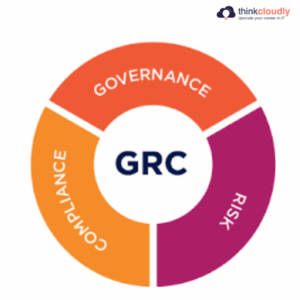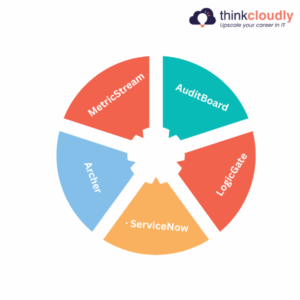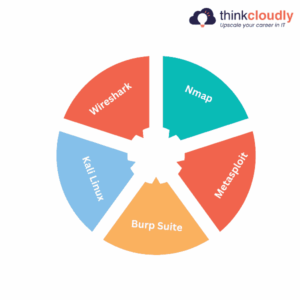As we all know Businesses in today’s digital environment confront several challenges in maintain data security and legal compliance. There are two important concepts that help in this area are GRC and Cybersecurity. They may sound same, but their functions are distinct. Building a safe and effectively run company requires an understanding of the distinction between GRC and Cybersecurity. It is necessary to have a thorough grasp of GRC and Cybersecurity before you can comprehend how they differ from one another.
So, we will begin with introduction to GRC and Cybersecurity before comparing them.
Let’s get going and discover the core of these two powerful concept.
What is GRC?
Governance, Risk , and Compliance are referred to as GRC. It is a wide approach that organizations apply to ensure they meet legal requirements, business goals and minimize risks.
- Governance: It Guarantees the organization’s decision-making process and structure are clear. It involves setting goals, responsibilities, and policies.
- Risk: It is the process of identifying and addressing possible issues that might harm the company. Risks can be financial, operational, or digital.
- Compliance: It verifies that the company complies with internal, legal and regulatory guidelines.
Overall GRC focusses on how the company is managed and how it aligns business activities with regulations and risk managements.
Are you intrested in how GRC frameworks help create safe and legal organizations? to learn more about the top 5 GRC frameworks in use,visit out blog and click here
What is Cybersecurity?
The practice of programs, networks, and systems from online threats is known as cybersecurity. Because there are more gadgets than humans and attackers are getting more creative, it is especially difficult to implement effective cybersecurity measures nowadays. Protecting digital assets and preventing unwanted access are the main goals of cybersecurity.
Cybersecurity includes:
- Software for antivirus
- Controls of access
- Security of networks
- Firewalls
How GRC and Cybersecurity Work Together
Despite their differences, Cybersecurity and GRC are related to and supportive of one another. You can think of GRC as setting the rules and Cybersecurity as enforcing them.
Here’s how they work together:
- GRC helps to create the policies and frameworks , such as data protection rules and regulations that guide how an organization should behave.
- Cybersecurity uses technology to put such regulations into practice, protecting systems and data with techniques like intrusion detection systems, firewalls, and encryption.
- GRC manages risk by spotting threats that could harm the organization. Then, by protecting weak points, cybersecurity steps in to counter such attacks.
Let’s look at the simple scenario:
If a business is required by law to protect client data, GRC make sure that the policy is in place and that staff members are taught on it. By employing secure login procedures and encryption to protect the real data, cybersecurity goes one step further.
In simple words GRC sets the strategy and rules, and Cybersecurity uses technology to make sure those rules are followed or not.
Who is GRC analyst?
GRC analyst making sure that the company complies with cybersecurity regulations. A GRC analyst is also supposed to manage the risks that the company faces and make sure that the current risk policies and processes match the company’s overall cybersecurity goals and objectives
Key Responsibility of GRC Analyst
- Observe the laws and regulations
- Identify and address risks
- Assistance with Business Rules
Observe the laws and regulations : Verify that the business is operating in compliance with all applicable laws and industry standards.
Identify and address risks: Examine for any risks (such as legal or security issues ) and assist in resolving them before they become problematic.
Assistance with Business Rules: Establish and maintain procedures and standards so that everyone in the organization is aware of what to do to be safe and comply the regulations
Tools and Technologies Used by GRC Analysts
Who is Cybersecurity Analyst?
An Expert who tries to protect an organization’s whole IT infrastructure from potential internet threats is known as a cybersecurity analyst. They assess ,plan ,and implement security measures to reduce risks before they become incidents. This role requires a deep understanding of cybersecurity principles, along with skills in vulnerability assessment and risk management.
Key Responsibility of Cybersecurity Analyst
- Awareness and Training
- Risk Assessment and Management
- Security Audits
Awareness and Training: To inform staff members about acceptable security procedures, cybersecurity analysts frequently lead training sessions.
Risk Assessment and Management: Cybersecurity experts assess the organization’s security protocol and detect possible weak points.
Security Audits: Finding vulnerabilities before they are exploited through routine audits and vulnerability assessments.
Tools and Technologies Used by Cybersecurity Analyst
A Comprehensive Comparison of Cybersecurity and GRC
| Aspect | GRC(Governance, Risk and Compliance) | Cybersecurity |
|---|---|---|
| Definition | An organized method for coordinating risk management and compliance needs with corporate objectives. | The process of defending data, networks, and digital systems from online attacks. |
| Primary Focus | Regulatory compliance ,policy enforcement, risk management, and business procedures. | Preventing unwanted access, assaults, and harm to digital infrastructure and data. |
| Scope | Covers every aspect of the company ,including operations, IT, Financial, legal, and human resources | Primarily concerned with information technology and digital resources such as networks, servers, and user data. |
| Tools Used | Risk registers, audit management systems, and GRC platforms(such as Archer, ServiceNow, RSA) | Firewalls, antivirus software, IDS/IPS,SIEM tools(Splunk, QRadar). |
| Team involved | Compliance officers, internal auditors, governance professionals. | Cybersecurity engineers, SOC analyst, ethical hackers. |
Conclusion:
Both GRC and Cybersecurity are essential for protecting firms in a world where digital risks and regulatory requirements are Constantly evolving. GRC focuses on creating regulations ,managing risks, ensuring that laws and policies are followed. On the other hand Cybersecurity helps to protect data and systems from actual threats. Organizations may create a digital environment that is more robust, secure, and compliant by comprehending the linkages and distinctions between these two domains. Whether you are creating laws or defending against cyberattacks, having both GRC and cybersecurity in place is essential for long-term success.








No comment yet, add your voice below!